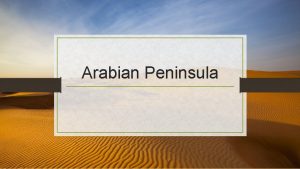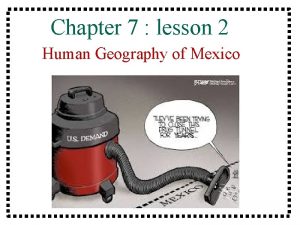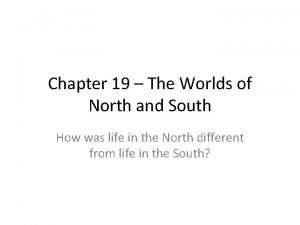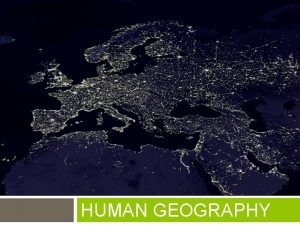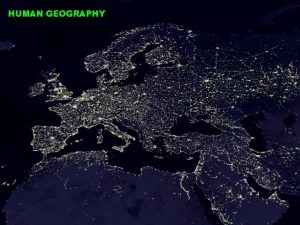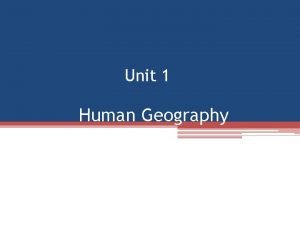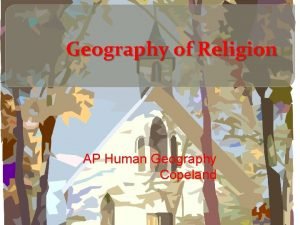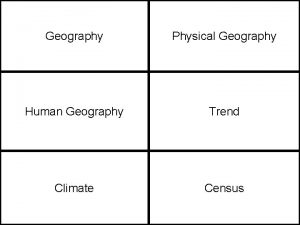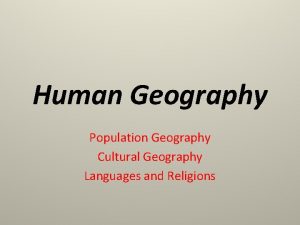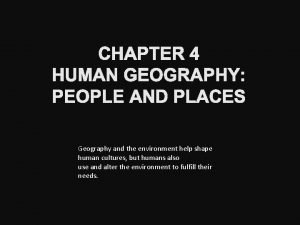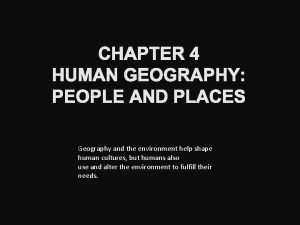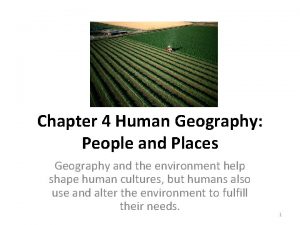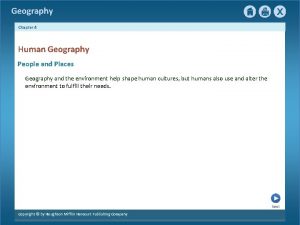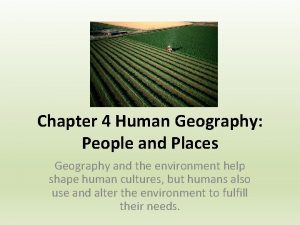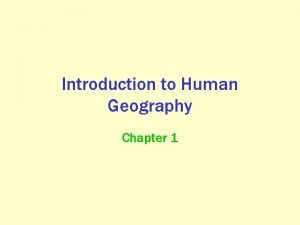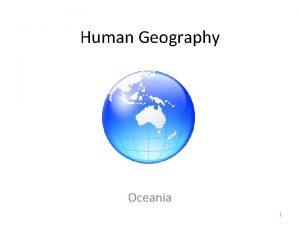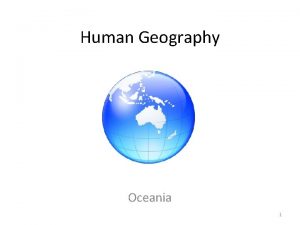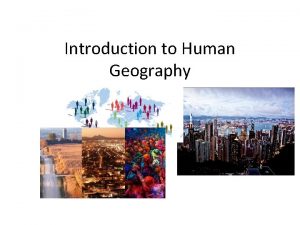Human Geography Lesson 1 The Worlds People EQ
























- Slides: 24

Human Geography Lesson 1: The World’s People EQ: How do people adapt to their environment? 3 B , 4 C , 4 D , 7 A , 7 B , 15 E , 18 A , 22 A

• 3 B The student is expected to: pose and answer questions about geographic distributions and patterns for various world regions and countries shown on maps, graphs, charts, models, and databases; • 4 B The student is expected to: identify and explain the geographic factors responsible for patterns of population in places and regions; • 4 C The student is expected to: explain ways in which human migration influences the character of places and regions; • 4 D The student is expected to: identify and locate major physical and human geographic features such as landforms, water bodies, and urban centers of various places and regions; • 7 A The student is expected to: identify and analyze ways people have adapted to the physical environment in various places and regions; • 7 B The student is expected to: identify and analyze ways people have modified the physical environment such as mining, irrigation, and transportation infrastructure; and • 15 E The student is expected to: analyze the similarities and differences among various world societies; and • 18 A The student is expected to: explain the relationships that exist between societies and their architecture, art, music, and literature; • 22 A The student is expected to: use social studies terminology correctly;

Textbook, pg. 86, Chapter 3, Lesson 1 The World’s People

1800 World population was about 860 million people. Next 100 Years Doubled to nearly 1. 7 billion people. 2013 Passed 7 billion people.

Earth’s Growing Population EQ: What factors contribute to Earth’s constantly rising population? Death rate: the number of deaths compared to the total number of individuals in a population in a given time. Birthrate: the number of babies born compared to the total number of individuals in a population at a given time. On average, 154, 080 people die each day worldwide. On average, about 215, 120 babies are born each day worldwide. When the Birthrate is larger than the Death rate, population increases.

Falling Death Rate Better Health Care Cleaner Water Causes of Population Growth Availability of Food Rising Birthrates Effects Cultures are Blended and Enriched Resources are Used Quickly Environments are Polluted Cities Grow and Urbanization Endangers Natural Areas

Doubling Time The number of years it takes a population to double in size based on its current growth rate. In some parts of Asia and Africa, the doubling time is 25 years or less. It can be short or long. Canada, on the other hand, the doubling time of countries with slow growth rates can be more than 75 years.

Global Growth Rate is Slowing Despite the fact that the global population is growing, the rate of growth is gradually slowing. The United Nations Department of Economic and Social Affairs predicts that the world’s population will peak at 9 billion by the year 2050. After that, the population will begin to decrease.

Population Challenges When the population of an already crowded are continues to grow, serious problems can arise. • Diseases spread quickly • Lack of jobs and work for people • Household live in ongoing poverty • Crime rates spike in large population areas

Population growth is different in different areas so these problems are more severe than in other places. What is the difference between the birthrate and death rate?

Population Patterns EQ: Why do more people live in some parts of the world than in others? Some families live in the same town or on the same land for generations. Others people frequently move from place to place. Why do you think that some people move frequently while others never move or stay in the same area?

Where are they located? Population Distribution: the geographical pattern of where people live on Earth. Population Density: the average number of people living within a square mile or a square kilometer. Population distribution is uneven across the planet. Large population areas occur because of jobs, religion, or government transportation services. To say that an area is densely populated means the area has a large number of people living within it. Population density for a country is the average for the entire country.

Where People are Located Urban: areas that are densely populated. Rural areas are sparsely populated.


Land Vs. Water People in habit only a small part of Deserts, oceans, and the Earth. mountaintops are mostly uninhabited. Land covers only 30% of Earth’s surface. ½ of that is not usable to Humans. Only 15% of the Earth’s surface is habitable.

Reasons Why People Settle in an Area The Main reasons are • Shelter • Food • Water • A way to learn a living Some people live in cities, which have many places to live and work. Other people make their homes on open glasslands where they build their own shelters, grow their own food, and raise livestock.

Give on example of an Urban Area and one example of a Rural Area.

Population Movement EQ: What are the causes and effects of human migration? The populations of different areas change as people move from one area to another. Migration: people moving from one place to another. Emigrate: to leave one’s home to live in another place. Immigrate: to enter and live in a new country. Refugee: people who flee a country because of violence, war, or persecution.

Push and Pull Factors The reasons for leaving one area and going to another are called push-pull factors. Push factors drive people from an area. Pull factors attract people to an area. The movement of people from one area to another can affect the land, resources, culture, and economy of an area. Some of these effects are positive, but others can be harmful.

War Poverty Causes of Migration Family Issues Cultures are Blended and Enriched Lack of Opportunities Effects of Migration Cities Grow and Urbanization Endangers Natural Areas Human Rights Issues Resources are Used Quickly Environments are polluted

Causes of Urbanization: when cities grow larger and spread into surrounding areas. Migration is a primary reason that urbanization occurs. People move to cities for many reasons. • To find jobs • Business opportunities • Transportation and trade centers • Medical services • Education • Entertainment • Housing • Food sectors

Effects of Urbanization As more people migrate to cities, urban areas become increasingly crowded. • Cities expand • Farmland is turned into homes, apartment buildings, factories, offices, schools, and stores • Loss of farmland means: • Food must be grown further from cities • Adding additional shipping • Increasing pollution • Cities grow into each other Megalopolis: a huge city or cluster of cities with an extremely large population.

Megalopolis The term megalopolis was coined in 1961 by French geographer Jean Gottmann after he spent two decades in an area of the United States that stretches from New Hampshire to Washington, D. C. In his study, he argued that as population growth increased in the cities in this region, people moved to smaller nearby areas that grew into large suburbs and “merged” with other metropolitan regions in the area.

Question: In your own words, briefly summarize the main reasons people emigrate from their homelands.
 Worlds together worlds apart 4th edition
Worlds together worlds apart 4th edition Ap human geography frq examples
Ap human geography frq examples 5 themes of geography ap human geography
5 themes of geography ap human geography Ap human geography political geography test
Ap human geography political geography test Human development index definition ap human geography
Human development index definition ap human geography Choke points definition ap human geography
Choke points definition ap human geography What influenced mexico's political and social structures
What influenced mexico's political and social structures Lesson 19 the worlds of north and south
Lesson 19 the worlds of north and south Hát kết hợp bộ gõ cơ thể
Hát kết hợp bộ gõ cơ thể Slidetodoc
Slidetodoc Bổ thể
Bổ thể Tỉ lệ cơ thể trẻ em
Tỉ lệ cơ thể trẻ em Chó sói
Chó sói Thang điểm glasgow
Thang điểm glasgow Chúa yêu trần thế
Chúa yêu trần thế Các môn thể thao bắt đầu bằng tiếng đua
Các môn thể thao bắt đầu bằng tiếng đua Thế nào là hệ số cao nhất
Thế nào là hệ số cao nhất Các châu lục và đại dương trên thế giới
Các châu lục và đại dương trên thế giới Công thức tính độ biến thiên đông lượng
Công thức tính độ biến thiên đông lượng Trời xanh đây là của chúng ta thể thơ
Trời xanh đây là của chúng ta thể thơ Mật thư tọa độ 5x5
Mật thư tọa độ 5x5 Làm thế nào để 102-1=99
Làm thế nào để 102-1=99 độ dài liên kết
độ dài liên kết Các châu lục và đại dương trên thế giới
Các châu lục và đại dương trên thế giới Thể thơ truyền thống
Thể thơ truyền thống





